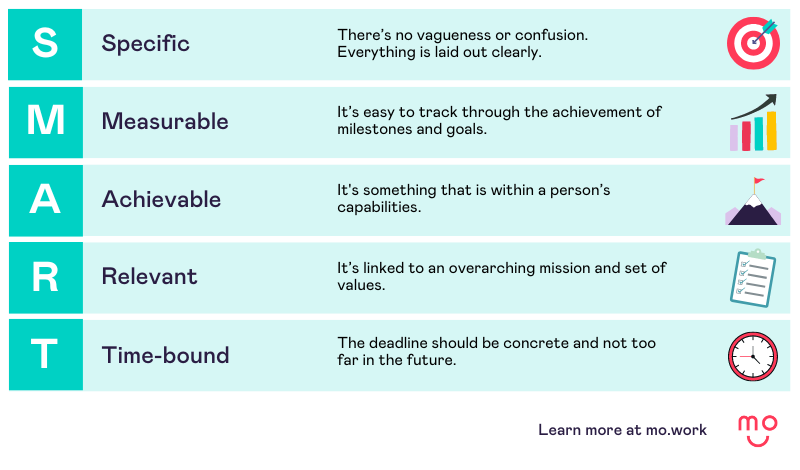SMART goals make personal growth and success easier for leaders and team members alike. Setting SMART leadership goals is a technique you can learn in no time.
What is a SMART leadership goal?
SMART leadership goals are objectives that follow a clear framework, making them specific, measurable, achievable, realistic, and timely. By following this method, it’s much easier to drive transformation and achieve solid results.
So how does this framework break down? There are five essential elements that make SMART goals so effective.

- Specific. There’s no vagueness or confusion. Everything is laid out clearly.
- Measurable. It’s easy to track through the achievement of milestones and goals.
- Achievable. It’s something that is within a person’s capabilities.
- Relevant. It’s linked to an overarching mission and set of values.
- Time-bound. The deadline should be concrete and not too far in the future.
How do SMART goals make you a better leader?
SMART goals can make you a better leader by giving you an opportunity to assess your strengths and weaknesses. Great leaders know how to set clear, measurable objectives for themselves and their teams. Goal setting with SMART goals is a great way to do it.
How to set SMART leadership goals
Setting a SMART leadership goal is a question of looking at your leadership goals and finding ways to improve them. To ensure your goals are as effective as possible, make sure that they align with your short and long-term ambitions.
11 SMART leadership goal examples for managers and leaders
Learn how to set your own SMART goals by checking out our examples. Each example comes with a breakdown of the goal, showing how the SMART framework can be used.
1. Improving communication skills
SMART goal: Effective communication is essential for leaders. The goal is to take part in online training for assessing your communication style and learning new methods. Gather anonymous feedback from your team and aim for a 75% improvement rate in a six-month period.
S – Including the requirement of completing an online training course makes sure there’s a specific element to the goal.
M – Tracking feedback from your team means that you won’t only have to rely on your own perceptions of progress.
A – This goal is attainable because completing an online course should be easily achievable and regular constructive feedback allows you to check the results.
R – The ability to clearly communicate with your team is a cornerstone for every interaction, so it will always be relevant to overall goals.
T – This has a deadline allowing enough time to both complete a course and to measure for changes and improvements.
2. Enhancing presentation skills
SMART goal: Presentations can be inspiring – or incredibly dull! Improving your ability to deliver is a solid goal. Plan to watch one presentation and read one resource a week for a month. In the following three months, ensure you’re delivering one presentation every second week and plan to receive an 80% satisfaction rate from peers.
S – Setting out a number of research presentations to watch, ways to glean tips and the number of presentations you will give ensures you have specific aims.
M – Looking to achieve an 80% satisfaction rate gives you a measurable goal to work towards.
A – Make this achievable by dedicating an hour and a half a week to research for the first month, then delivering a set number of presentations.
R – This is relevant for leaders who want to be able to increase buy-in and inspire teams.
T – The four-month time limit allows enough time to dedicate to research and practice.
3. Boost cross-functional collaboration
SMART goal: Leaders looking to encourage more cross-functional collaboration can set themselves objectives to help their teams. The first is to assign everyone roles within two weeks, then establish bi-weekly check ins to ensure everyone is aligned. Set up a centralised space for communication and use a regular anonymous survey to check if priorities are aligned, aiming for an 80% crossover rate within six months.
S – Assigning roles not only allows teams to function more smoothly, but it is also a specific change with a clear goal.
M – You can assess the success of assigning roles and also use the anonymous survey to measure their success and adjust if needed.
A – Setting up a communication platform and assigning roles can be an achievable goal for most leaders.
R – Cross-functional collaboration is relevant for organisations that need teams to be able to work together towards a common goal.
T – Establishing frequent check ins and a deadline for the alignment of roles within the teams within six months.
4. Improve employee engagement
SMART goal: Employee engagement should be top of the agenda for all leaders. Raise a team’s engagement score by 15% within three months by recognising achievements, offering opportunities for career development and conducting regular one to ones.
S – Increasing employee engagement by creating a better environment for your team to thrive is a specific and recognisable goal.
M – It’s easy to measure how well your efforts are working by using employee engagement surveys and by tracking your retention rate.
A – Attempting to raise your engagement score by 15% is realistic, if you’re able to offer the right incentives and environment.
R – An engaged workforce is one that is happier and less likely to leave, and with one in four employees at high retention rick according to Quantum Workforce, this is relevant to all leaders.
T – This should be a regular quarterly goal or one that you revisit at least once a year.
5. Become more adaptable
SMART goal: Today’s leaders need to be highly adaptive and able to cope with quickly changing landscapes. Improve your adaptability by booking a change management course and applying its learnings. Once the course is completed, track each time you’ve applied your learnings within a four-month period.
S – Becoming more adaptable is too vague as a goal. You can make it specific by attaching the need to take part in a change management course.
M – Measure your progress by making sure to record each time you make use of the things you’ve learned.
A – Finding and completing a course offers an achievable element to this goal.
R – Adaptability is an important skill for leaders, who are expected to guide their organisations through change.
T – Four months is a reasonable amount of time to find and complete the course. After this, you will have opportunities to apply the learnings.
6. Develop people on your team
SMART goal: Build on the skills your team already has, by putting the focus on their development. Plan to meet up with every member of the team for an in-depth look at their goals within one month. Work with HR to implement clear pathways and aim for 75% notice of these options within a year.
S – Learn what the career goals are for each of your team members and create opportunities.
M – Track the number of team members who make use of these opportunities. Also take the time to question any who aren’t, in case there are barriers you can help with.
A – This is an attainable goal because it involves discovering what your team’s needs are and meeting them.
R – Employee development is incredibly important to people and can help upskill your team and boost your retainment.
T – Honing skills and setting up opportunities can take time, so give yourself a year to attain 75% pick up.

7. Get better at delegating
SMART goal: Good leaders know when to delegate. Get to grips with this skill by setting yourself a goal of delegating at least two tasks a week and hand over at least two substantial projects within four months. Track the success rates of everything you’ve handed over.
S – Choosing a set number of tasks and projects to hand over means you will have to get comfortable with making the change.
M – Be sure to keep a note of how many tasks you hand over and also track how successful they are.
A – It’s realistic that you can become more comfortable delegating tasks within four months, as long as your effort and communication is consistent.
R – This is an essential skill for leader of high performing teams, as it allows you to avoid micromanaging and can help improve employee confidence.
T – While it may take longer for you to be completely happy delegating, four months is a reasonable goal for making important strides.
7. Get better at delegating
SMART goal: Good leaders know when to delegate. Get to grips with this skill by setting yourself a goal of delegating at least two tasks a week and hand over at least two substantial projects within four months. Track the success rates of everything you’ve handed over.
S – Choosing a set number of tasks and projects to hand over means you will have to get comfortable with making the change.
M – Be sure to keep a note of how many tasks you hand over and also track how successful they are.
A – It’s realistic that you can become more comfortable delegating tasks within four months, as long as your effort and communication is consistent.
R – This is an essential skill for leader of high performing teams, as it allows you to avoid micromanaging and can help improve employee confidence.
T – While it may take longer for you to be completely happy delegating, four months is a reasonable goal for making important strides.
8. Consistently recognise team contributions
SMART goal: Ensuing that employees feel appreciated is key for improving engagement. Give yourself a month to build a habit for recognising team members consistently. Start by pinpointing several suitable platforms, then begin acknowledging employee contributions in a variety of ways. Remember to track how often team members are recognised.
S – The specific aim is to increase the frequency of your public or private recognition of the efforts of your employees.
M – It is easy to measure this goal by tracking the number of ways you recognise your various employees.
A – This is achievable, especially if you monitor progress. Mo can help you not only track opportunities for celebration, such as birthdays or anniversaries, but also how often individuals are being recognised.
R – Recognising and rewarding employees is key to helping them thrive in any workplace.
T – This short-term goal can help you build important long-term habits.
9. Develop greater emotional intelligence
SMART goal: Gitnux reports that 90% of top performers have high emotional intelligence. Strengthen yours by committing to practicing mindfulness exercises for five minutes a day for one week, increasing to ten minutes the week after and continuing to increase in five minutes increments until you reach half an hour a day.
S – Committing to exercises ensures that you have a specific goal, even though the outcome is harder to quantify.
M – Use a timer to keep track of how long you are spending practicing mindfulness.
A – This goal is a highly achievable one because it is rooted in your own commitment to change and willpower.
R – Emotional intelligence can help you handle stress more easily and leave you better equipped to deal with difficult situations.
T – By committing to increasing your practice in increments of five minutes until you’re spending half an hour a day, you’re creating a time-bound goal.
10. Get better at asking for feedback
SMART leadership goals: Being able to ask for feedback can be difficult for leaders, but it’s a useful skill. Plan to ask for feedback at the end of every major project or presentation for the next three months. Add a question about how you’re doing into one-to-ones with core colleagues and source wider feedback from the team at least twice.
S – Setting yourself the goal of asking for feedback in particular situations ensures this goal has a specific outcome.
M – Keep an eye on how many times you ask for feedback and take note of the platforms you use. As well as asking for feedback in person, make use of communication platforms like Mo to ask for feedback on projects.
A – Asking for feedback is a very achievable goal, especially if you employ more than one technique.
R – Feedback can help you grow as a leader and make it easier for to you to guide your team to success.
T – Give yourself a three-month deadline so that you can easily assess how successful your attempts at asking for feedback have been.
11. Run more effective meetings
SMART leadership goals: Make the most of your time, by learning how to run more effective group or one-to-one meetings. Plan to improve time management with clear meeting agendas and time limits for your meetings within the next two months.
S – Introducing time limits and agendas into meetings is a specific goal designed to help your team stay focused and engaged throughout.
M – Make a note of how often you manage to cover all of the items on the agenda and how often you run over time.
A – This is a practical strategy that is achievable as a starting out point for running more efficient meetings.
R – Maximising the efficiency of the time spent in meetings can help your company as a whole.
T – Two months is a reasonable amount of time to implement and measure this goal.
4 best practices for setting your SMART leadership goals
Only you will know the timelines that are possible in your situation or the resources that are available. That’s why you should be the one who sets your own SMART goals. However, there are some best practice guidelines that can make the process of setting leadership goals easier.
1. Start by assessing the opportunities available and the potential roadblocks in place. It’s important to be realistic about what you may be able to achieve, while also being optimistic about the results. Looking at the good and bad helps set goals that are relevant, time-bound, and have specific outcomes.
2. Always look at the ways that your goals reflect back to your organisation’s aims and values. While your leadership goals may be highly personal and are a form of career development, aligning them with overarching objectives offers you an extra incentive and sense of purpose.
3. Get your team involved, especially when it comes to goals that directly affect your interactions. This not only helps you, by offering feedback and support, but it can also build trust, inspire your team to work on their own personal goals and increase feelings of ownership for the end result.
4. Make sure that SMART leadership goals become part of your routine. Integrate them into your performance reviews and set both sort and long-term goals. They can help your create a sensible and sustainable pathway to improvement and become part of your growth trajectory.
Transform your culture with Mo

- Improve employee engagement scores
- Reduce employee churn
- Build a collaborative culture
Mo is a new kind of reward and recognition platform that makes it easy for busy managers to meaningfully recognise, engage and connect with their teams.
We equip managers with weekly suggestions to energise and connect with their people, help teams build habits of recognition into their day-to-day rhythms and go beyond simple rewards as a way to motivate staff.
Join companies like SHL, OVO Energy and William Hill in delivering meaningful improvement.



